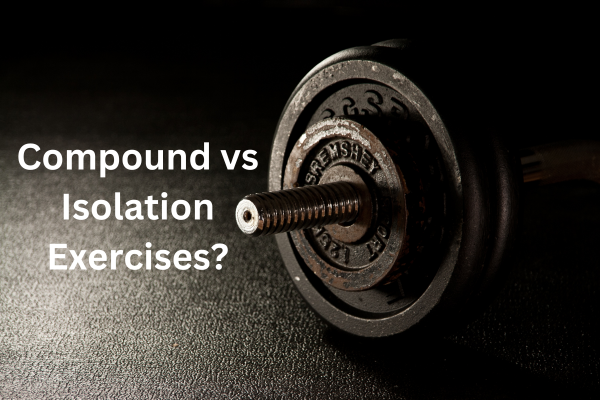Choose between Compound vs Isolation Exercises in 2024: Optimize your Fitness Journey.

In the world of fitness and exercise, the debate between compound and isolation exercises has been ongoing. As we venture into 2024, optimizing your workout routine becomes increasingly crucial for achieving your fitness goals. Understanding the nuances between compound vs isolation exercises can significantly impact the effectiveness of your training program.
Understanding Compound Exercises
In Compound exercises, multiple muscle groups and joints work simultaneously. Examples include squats, deadlifts, and bench presses. These movements involve a large number of muscles, making them efficient for building overall strength and muscle mass. For instance, squats target not only the quadriceps but also the glutes, hamstrings, and core muscles.

Understanding Isolation Exercises
On the other hand, isolation exercises target specific muscles or muscle groups. Exercises like bicep curls, tricep extensions, and leg extensions isolate a particular muscle, allowing for focused muscle engagement and development. For example, bicep curls isolate the biceps brachii muscle, helping to sculpt and define the arms.
Also, Isolation exercises play a pivotal role in enhancing the mind-muscle connection. Performing exercises slowly and deliberately with machines or bands facilitates focused engagement of specific muscle groups. This technique is invaluable for developing strength in areas crucial for advanced movements like pull-ups.

Comparison: Compound vs Isolation Exercises
While between Compound vs Isolation exercises both offer unique benefits, understanding their differences is crucial for tailoring your workout routine to your specific goals. Compound exercises excel in building overall strength and muscle mass, while isolation exercises are effective for targeting specific muscles and achieving definition.
Advantages of Compound vs Isolation Exercises
Compound Exercises:
- Efficient use of time: Compound exercises engage multiple muscle groups simultaneously, allowing for shorter, more efficient workouts.
- Functional strength: Compound movements mimic real-life activities, improving overall functional strength and mobility.
- Caloric expenditure: Due to their high intensity, compound exercises can aid in calorie burning and weight management.
Isolation Exercises:
- Targeted muscle development: Isolation exercises allow for precise targeting of specific muscle groups, aiding in muscle definition and sculpting.
- Injury prevention: By focusing on individual muscles, isolation exercises can help correct muscular imbalances and reduce the risk of injury.
- Variety and customization: Isolation exercises offer a wide range of variations, allowing for customization to target specific areas of concern or weakness.
Challenges of Compound vs Isolation Exercises
Compound Exercises:
- Technical Complexity: Compound exercises involve multiple joints and muscle groups working together in synchrony. Mastering proper form and technique for movements like squats, deadlifts, and bench presses can be challenging, especially for beginners.
- Risk of Injury: Due to their complexity, compound exercises carry a higher risk of injury if performed with incorrect form or technique. Overloading the body with heavy weights without proper preparation or supervision can lead to strains, sprains, or more severe injuries.
- Fatigue and Recovery: Compound exercises are demanding on the central nervous system and require significant energy expenditure. As a result, individuals may experience quicker fatigue during workouts, necessitating longer recovery periods between sessions.
- Plateauing: While compound exercises are effective for building overall strength and muscle mass, individuals may reach a plateau in progress over time. Without proper variation and progression, muscles may adapt to the stimulus provided by compound movements, hindering further gains.
Isolation Exercises:
- Limited Functional Application: Isolation exercises target specific muscle groups in isolation, which may not directly translate to real-life movements or functional activities. This lack of functional carryover may limit their effectiveness in improving overall physical performance.
- Muscle Imbalances: Overreliance on isolation exercises without adequate compound movements can lead to muscle imbalances. Focusing solely on isolated muscle groups may neglect synergistic muscles, increasing the risk of imbalances and potential injury.
- Time-Consuming: Performing a comprehensive workout incorporating numerous isolation exercises for each muscle group can be time-consuming. Individuals with limited time may find it challenging to include a variety of isolation exercises in their training regimen.
- Equipment Dependency: Some isolation exercises require specialized equipment or machines, which may not be readily available in all gym settings. This reliance on specific equipment can limit exercise variety and accessibility for individuals training outside of traditional gym environments.
Compound vs Isolation Exercises- Which one to choose?
Depending on the individual’s specific objectives, one can make a decision between compound vs isolation exercise.
- For individuals seeking overall strength and muscle mass, incorporating compound exercises into their routine is essential.
- Those looking to sculpt and define specific muscle groups may benefit from incorporating isolation exercises alongside compound movements.
- Ultimately, the best approach is a balanced combination of both compound and isolation exercises tailored to individual goals and preferences. A balanced approach ensures comprehensive muscle development while targeting specific areas for definition and sculpting. For example, a workout routine may include compound exercises like squats and bench presses alongside isolation exercises such as bicep curls and tricep extensions.
Factors to Consider
When determining the ideal workout routine (compound vs isolation exercises), several factors come into play such as:
- Individual fitness levels, preferences, time constraints, and equipment availability. Tailoring your program to suit your unique circumstances ensures sustainability and long-term success.
- Also, regardless of the type of exercise (between compound vs isolation exercises), proper form and technique are paramount for preventing injury and maximizing results.
- Additionally, implementing progressive overload and varying your workouts keeps your muscles challenged and promotes continuous growth.
- Focus on maintaining proper alignment and engaging the target muscles throughout each repetition.
Consulting with a trainer or expert can provide valuable insights and guidance for crafting an effective and sustainable exercise plan. An experienced coach can assess your current fitness level, provide personalized recommendations, and monitor your progress to ensure optimal results.
Common Myths Busted
In the world of fitness, misinformation often abounds. By busting common myths surrounding compound vs isolation exercises, individuals can make informed decisions and optimize their training for maximum results. For example, one prevalent myth suggests that isolation exercises are only beneficial for bodybuilders, while in reality, they can benefit individuals of all fitness levels seeking muscle definition and toning.
Conclusion
In conclusion, optimizing your workout routine in 2024 requires a comprehensive understanding of compound vs isolation exercises. By incorporating a balanced mix of both types of movements, you can achieve your fitness goals more efficiently and effectively. Remember to prioritize proper form, listen to your body, and stay consistent on your journey to a healthier, stronger you.
If you wish to read more similar articles. Click here
Frequently Asked Questions:
Compound exercises involve multiple muscle groups and joints working simultaneously, making them efficient for building overall strength and muscle mass.
Isolation exercises target specific muscles or muscle groups, allowing for focused muscle engagement and development.
While compound exercises are beneficial for overall strength and muscle mass, incorporating isolation exercises can target specific areas for definition and sculpting.
The frequency of isolation exercises depends on your individual goals and preferences. Aim to incorporate them regularly to target specific muscle groups effectively.
There is no one-size-fits-all answer to this question. Some individuals prefer starting with compound exercises to maximize strength and energy levels, while others may prioritize isolation exercises for targeted muscle engagement. Experiment with different approaches to determine what works best for you.

1 thought on “Choose between Compound vs Isolation Exercises in 2024: Optimize your Fitness Journey.”
Pingback: Top 5 Chest Isolation Exercises in 2024: Strength and Definition